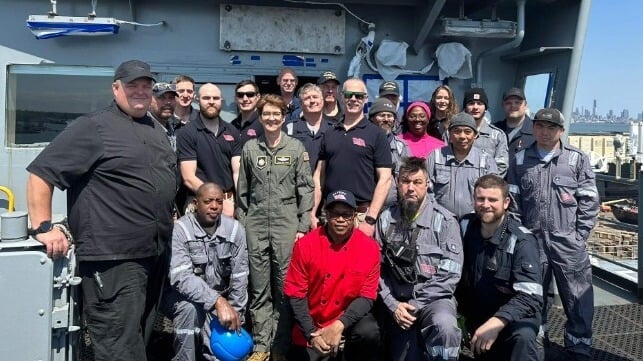Sealift or Sink: The Urgent Need to Renew U.S. Maritime Capacity

The next global war will be waged with artificial intelligence, robots and hypersonic weapons. While our combat capabilities are unmatched, the sealift we need to project and sustain the fight is becoming overwhelmed.
Our nation's heritage as a maritime power has endured since the very founding of this great union. Our ability to protect our coasts, sustain our industries, support our allies and project power abroad is a national strength built on the water. But our sealift prowess is at risk.
Current events prove that our warfighting enterprise is being challenged in all domains. Contested waters stress our logistics lines starting in home port, and service concepts of maneuver drive increased transportation requirements. Threats to democracies and rule of law exist today, and like the heroes before us, we must be ready to defend our freedoms.
In a conflict, I expect up to 90% of our requirements to project forces and sustainment will move by sealift. There is no doubt about it: Sealift is vital to delivering a decisive force. But in ten years, more than half of those ships will either be too expensive to maintain or retire altogether.
U.S. Transportation Command (USTRANSCOM) is a global combatant command that supports the geographical combatant commanders. To maintain our unrivaled strategic advantage to project and sustain the joint force over global distances at the time and place of our choosing — through natural disasters, pandemics, conflicts and defending the homeland — we must recapitalize and modernize our aging mobility capabilities.
Even when we count on our allies and partners to support the U.S. in areas where they are able, reliable and relevant U.S. sealift capability is essential to deploy forces in any significant conflict. While USTRANSCOM does not own the maritime resources or the industrial base to address the growing maritime problems, we remain a strong advocate for the national maritime industry.
Alongside the U.S. Navy, U.S. Maritime Administration (MARAD), and U.S. Department of Transportation (DOT), USTRANSCOM supports the initiatives needed to keep our nation competitive at sea. We cannot afford to get this wrong; the stakes are too high.
We're making positive changes based on the attention from legislators through strong support in the annual National Defense Authorization Act. Recapitalizing our U.S. Ready Reserve Force, and garnering support for heavily relied upon assured access programs are critical to emergency preparedness.
The Maritime Security Program, Voluntary Intermodal Sealift Agreement, Voluntary Tanker Agreement, the Jones Act and cargo preference laws, and the newly established Tanker Security Program all work together to ensure we have the necessary U.S. Flag capability and U.S. Mariners during peacetime, and readiness to move sensitive defense materiel during a national emergency.
We rely on commercial capabilities that enable Department of Defense joint power projection, and highlight the strategic nature of our shipyards and seaports as a reason why investments in grant programs like the Port Infrastructure Development Program are essential in expanding transportation nodes and capacity.
USTRANSCOM stands ready to help shape the new National Maritime Strategy, led by the DOT and MARAD, which will orient a whole of government effort to secure U.S. maritime capabilities.
We'll need more than just ships to get us there. We need U.S. merchant mariners.
Mariners were here when our nation was founded, carrying us to independence by moving Armies and goods and cutting off British ships.
They remain the backbone of our maritime capability, the lifeblood that powers our strategic sealift, and the soul of our maritime ecosystem. Their success drives our own, and I join those concerned about reports of a mariner shortfall.
Throughout history, mariners have secured our country’s commerce, sent forth combat power, and delivered with deeds, not words. They are critical to America's success in executing global distribution operations.
Take, for example, Ukraine and NATO. At a moment’s notice, we supported our allies and partners. It is because of strategic sealift that we are successfully fulfilling our nation’s ongoing critical role in materiel support to Ukraine, and ensuring NATO has the resources it needs to defend the alliance.
Nearly 70% of Ukraine's total security cooperation materiel has been delivered by government-owned ships or commercial vessels — all of which were operated by U.S. Mariners.
I stand with MARAD and fully support efforts to invest in providing proper resources that will grow the next generation of U.S. Merchant Mariners, whether they graduate from national or state-level academies, or non-licensing technical institutions.
I'm encouraged to hear about efforts to provide Mariners, sailing in certain positions, with increased leave and temporary promotion opportunities. These are all steps that will help to grow a stronger, more resilient U.S. Merchant Marine community.
Where we can do more to reduce known impediments to maritime service, we should. I support the U.S. Coast Guard’s efforts to modernize credentialing systems and initiatives that accelerate the certification of Merchant Mariners.
Our teammates come from all walks of life, and our diversity is our strength. Our nation is calling for the next generation of Mariners, so we must guide and encourage those showing interest — let's help them answer our nation's call.
Our U.S. Merchant Marine and sealift capabilities always have been, are, and always will be vital to our economy and national security. They continue to represent the difference between victory and defeat.
The call to action is urgent. It’s time to step forward in unified support. Together, we deliver!
Gen. Jacqueline D. Van Ovost (USAF) is the Commander of U.S. Transportation Command.
The opinions expressed herein are the author's and not necessarily those of The Maritime Executive.
